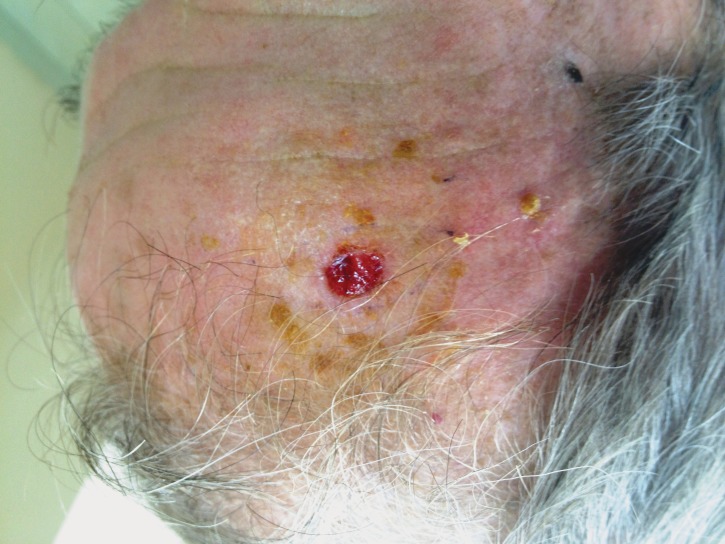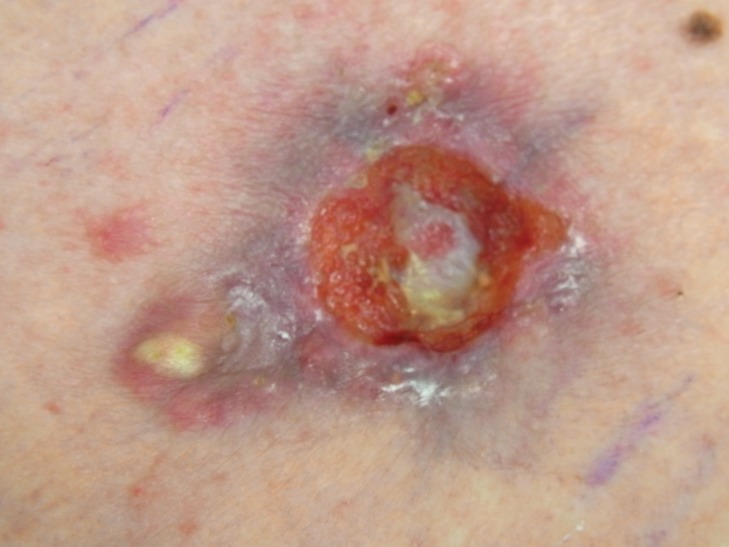Abstract
We present 2 rare cases of metatypical basal cell carcinoma - two 72-year-old male patients with ulcerative lesions localized either to the left forehead or the back. The biopsy revealed a metatypical basal cell carcinoma. The treatment consisted of a wide local elliptical excision with good cosmetic results. There was no sign of recurrence or metastasis during a 12 months follow-up period.
Basal cell carcinoma (BCC) and squamous cell carcinoma (SCC) make up 95% of the most common types of cancer in the world - the non-melanoma skin cancer (NMSC). BCC is known for its potential to be locally invasive while SCC for its potential to metastasize in lymph nodes. The meta-typical basal cell carcinoma (MTBC) is a rare type of tumor which combines the clinical and histopathological features of both BCC and SCC with a 5% risk for the development of metastases. The gold standard for diagnosis lies in the histopathological verification of the lesional tissue. Clinical examinations alone are not enough.
Keywords: metatypical basal cell carcinoma, histopathology, basosquamous carcinoma, surgery
INTRODUCTION
Non-melanoma skin cancer is the most common type of cancer in the world. Basal cell carcinoma (BCC) is the most common malignancy of the skin, accounting about 80% of all cutaneous cancers (1). Risk factors include high cumulative ultraviolet light (UV) exposure and having Fitzpatrick skin type I or II (2). Basal cell carcinomas develop from outer root hair follicle epithelium with preference for the head-and-neck region (3,4). Loss of function mutations in patched homologue-1 tumor suppressor (PTCH-1) or gain of function mutations activating PCTH-1 receptor smoothened (SMO) can be identified in the majority of BCC. One third of BCCs occur in non-sun-exposed areas. Nodular BCC is the most common type of BCC and classically presents with a raised and rolled border, often with fragility and intermittent bleeding (1).
Metatypical basal cell carcinoma (MTBCC) also referred as basosquamous carcinoma, is a rare variant of BCC, which shares clinical and histopathological characteristics of both BCC and SCC (5). MTBC was first described by MacCormac in 1910 as a histological version in a series of rodent ulcers in which basal cell and squamous cell tumors were present side by side without a transition zone (6). As such, it is considered a particularly aggressive form of BCC, with increased risk of metastases and higher recurrence rates than common BCC (5). MTBCC develop dissemination by perineuronal infiltration and metastatic spread in up to 5% (7-10). The terminology of this tumor is still controversial, while the literature data regarding its incidence, pathogenesis, natural course and optimal treatment are somehow scarce and not well defined (5). ❑
CLINICAL CASES
Medical History:
Case 1: The patient is 72 years old, Caucasian male with a history of extensive sun exposure who presented with a 4-months history of a lesion on the right forehead (Figure 1). The lesion was initially painless and slowly growing, with occasional spontaneous bleeding. Ulceration occurred approximately one month after the lesion first appeared.
Figure 1. Case 1. (a) Ulcerated nodule of the forehead.
Clinical examination revealed a 1.8 cm plaque, growing primarily endophytically, with central ulceration, located in the right front-parietal scalp (Figure 1). Multiple surrounding actinic keratoses were present (Figure 1). The tumour was removed by surgical excision with excellent cosmetic results. Histopathological examination has shown tumor islands with reticulated configuration composed of an incomplete outer layer of dark-staining basal cells and an inner layer, actually representing the majority of the tumor, featuring larger and lighter staining cells. The diagnosis of metatypical BCC from intermediate type has been made.
Case 2: A 72-year old Caucasian male with a 5 cm ulcerated large plaque on his upper back (Figure 2). Ulceration was noted because of the blood stains on the underwear. In other respects, the tumor was asymptomatic. The observational phase was of at least 24 months before the patient had to ask for professional help.
Figure 2. Case 2. Ulcerated plaque on the back.
The man had worked outdoors for more than 4 decades and he showed other signs of photo ageing, such as dermoheliosis.
Histopathological examination: Both tumors showed analogue histopathological findings. After a careful histopathological verification, an intermediate type of MTBC diagnosis was set.
Imaging/Laboratory investigations: Chest X-ray, MRI of the head and neck, abdominal ultrasound, sonographic evaluation of the lymph nodes of the neck, axilla, supraclavicular region and groins did not reveal any gross nodal or visceral metastases.
All routine serum laboratory measurements, including complete blood count and liver function tests, were normal.
Treatment and Outcome
Both tumors were removed with elliptical excision under local anesthesia. This was followed by primary closure with single stitches. The post-operative period was uneventful. Stitches were removed from the face on the 7th of the day post-operative period and after 3 weeks from the back. A very good therapeutic and cosmetic result was achieved after the application of Repaderm Gel twice daily for a period of 28 days (face only). ❑
DISCUSSION
The term metatypical basal cell carcinoma (MTBCC) or basosquamous carcinoma defines a histopathological variant that comprises features of both basal and squamous cell carcinomas, with or without a transition zone between them (8). Throughout, in the literature the terms "metatypical" and "basosquamous" are often used interchangeably, although some authors argue that basosquamous carcinoma is more appropriate as reflecting the likely pathogeny of the tumor (10).
MTBCC can be classified histologically into two subtypes: intermediate and mixed (7). The intermediate-subtype MTBCC is characterized by the presence of tumor lobules or nests composed of basaloid cells that mature into paler cells with more abundant cytoplasm (5,7). The mixed-subtype MTBCC is described as having features typical of basal cell carcinoma coexisting with areas of grouped squamous cells and often with the presence of focal keratinization, commonly referred as "squamous pearls" (8,11). Both histologically and clinically, MTBCC can be considered a BCC/SCC tumor hybrid (5,7,8,11).
Immunohistochemical analysis is useful in the diagnosis of MTBCC, as areas of basal cell carcinoma are Ber-EP4 and AE1/AE3 positive, while areas of squamous cell carcinoma are AE1/AE3 and CAM5.2-positive, with variable staining with epithelial membrane antigen (13, 14). The transition zone usually shows a decline in staining for Ber-EP4a (12,13).
Recently, Cigna et al. performed a retrospective study of 312 patients with MTBCC located on the face and on the scalp (14). They found a strong correlation between mixed subtype and ulceration, and between the intermediate subtype and positive surgical margin. Perineural invasion was not an uncommon finding in the latter (14). They concluded that the intermediate type of MTBCC seems more aggressive (14).
Compared to other types of BCC, MTBCC is considered to have a higher incidence of recurrence and an increased risk for metastasis (5). Recurrence rates between 10% and 48% have been reported (5,7,10,15,16). The metastatic rate can be as high as 5% to 7.4%, what seems to be an abrupt leap compared to BCC in general with less than 1:1000 (5,7,10,15,16). Currently there are no established guidelines regarding the treatment of MTBCC. However, there is a fairly good consensus that MTBCC should be regarded and treated as an aggressive form of BCC (5,6,10). Wider surgical margins than those for BCC should be taken. In addition, Moh's micrographic surgery is an excellent surgical option, where available, due to the lower recurrence rates when compared to the classic excision (17). Moh's surgery is particularly indicated for high-risk locations such as the ears, middle face, recurrent or large tumors and sensitive areas where cosmetic preservation is paramount (18,19). Close clinical follow-up for 5 years has been recommended (1,19).
Vismodegib is an oral inhibitor of the Hedgehog pathway approved by the US Food and Drug Administration. It is the first systemic treatment for patients with locally advanced or metastatic basal cell carcinoma that is not amenable to surgery and radiation (1). Probably, it could be also an alternative approach in patients with MTBCC, that are not treatable by surgery. ❑
CONCLUSIONS
The diagnosis of metatypical basal cell carcinoma requires a good clinical history and an appropriate cutaneous biopsy, allowing an accurate histopathological evaluation. This should be followed by a subsequent appropriate surgical excision. MTBC should be regarded as a more aggressive form of BCC, with a higher recurrence rate and an increased risk of metastasis (7). This has direct implications in the treatment and follow-up of these patients. ❑
CONFLICT OF INTEREST
none declared.
FINANCIAL SUPPORT
none declared.
References
- 1.Wollina U, Tchernev G. Advanced basal cell carcinoma. Wien Med Wochenschr. 2013;163:347–53. doi: 10.1007/s10354-013-0193-5. [DOI] [PubMed] [Google Scholar]
- 2.Rubin AI, Chen EH, Ratner D. Basal-cell carcinoma. N Engl J Med. 2005;353:2262–69. doi: 10.1056/NEJMra044151. [DOI] [PubMed] [Google Scholar]
- 3.Mantese SAO, Berbert ALCV, Gomides MDA, et al. Basal cell Carcinoma - Analysis of 300 cases. An Bras Dermatol. 2006;81:136–42. [Google Scholar]
- 4.Kasper M, Jaks V, Hohl D, et al. Basal cell carcinoma – molecular biology and potential new therapies. J Clin Invest. 2012;122:455–63. doi: 10.1172/JCI58779. [DOI] [PMC free article] [PubMed] [Google Scholar]
- 5.Tarallo M, Cigna E, Fino P, et al. Metatypical basal-cell carcinoma (MTC) or basosquamous carcinoma (BSC): surgical therapy. Ann Ital Chir. 2011;82:389–94. [PubMed] [Google Scholar]
- 6.MacCormac H. The relation of rodent ulcer to squamous cell carcinoma of the skin. Arch Middlesex Hosp. 1910;19:172–83. [Google Scholar]
- 7.Tarallo M, Cigna E, Fino P, et al. Metatypical basal cell carcinoma: a Clinical review. J Exp Clin Cancer Res. 2008;7:27–65. doi: 10.1186/1756-9966-27-65. [DOI] [PMC free article] [PubMed] [Google Scholar]
- 8.Martin RC 2nd, Edwards MJ, Cawte TG, et al. Basosquamous carcinoma: analysis of prognostic factors influencing recurrence. Cancer. 2000;88(15):1365–9. doi: 10.1002/(sici)1097-0142(20000315)88:6<1365::aid-cncr13>3.0.co;2-y. [DOI] [PubMed] [Google Scholar]
- 10.Garcia C, Poletti E, Crowson AN. Basosquamous carcinoma. J Am Acad Dermatol. 2009;60:137–43. doi: 10.1016/j.jaad.2008.09.036. [DOI] [PubMed] [Google Scholar]
- 11.Malone JP, Fedok FG, Belchis DA, et al. Basal cell carcinoma metastatic to the parotid: report of a new case and review of the literature. Ear Nose Throat J. 2000;79:511–9. [PubMed] [Google Scholar]
- 12.Kazantseva IA, Khlebnikova AN, Babaev VR. Immunohistochemical study of primary and recurrent basal cell and metatypical carcinomas of the skin. Am J Dermatopathol. 1996;18:35–42. doi: 10.1097/00000372-199602000-00006. [DOI] [PubMed] [Google Scholar]
- 13.Beer TW, Shepherd P, Theaker JM. Ber EP4 and epithelial membrane antigen and distinction of basal cell, squamous cell and basosquamous carcinomas of the skin. Histopathology. 2000;37:218–23. doi: 10.1046/j.1365-2559.2000.00999.x. [DOI] [PubMed] [Google Scholar]
- 14.Cigna E, Tarallo M, Sorvillo V, et al. Metatypical carcinoma of the head: a review of 312 cases. Eur Rev Med Pharmacol Sci. 2012;16:1915–8. [PubMed] [Google Scholar]
- 15.Tarallo M, Cigna E, Sorvillo V, et al. Metatypical carcinoma. A review of 327 cases. Ann Ital Chir. 2011;82:131–5. [PubMed] [Google Scholar]
- 16.Bowman PH, Ratz JL, Knoepp TG, et al. Basosquamous carcinoma. Dermatol Surgery. 2003;29:830–2. doi: 10.1046/j.1524-4725.2003.29217.x. [DOI] [PubMed] [Google Scholar]
- 17.Aldred WV, Ramirez VG, Nicholson DH. Intraocular invasion by basal cell carcinoma of the lid. Arch Ophthalmol. 1980;98:1821–2. doi: 10.1001/archopht.1980.01020040673016. [DOI] [PubMed] [Google Scholar]
- 18.Leibovitch I, Huilgol SC, Selva D, et al. Basosquamous carcinoma. Treatment with Mohs Microgaphic Surgery. Cancer. 2005;104:170–5. doi: 10.1002/cncr.21143. [DOI] [PubMed] [Google Scholar]
- 19.Wollina U, Bayyoud Y, Krönert C, et al. Giant epithelial malignancies (Basal cell carcinoma, squamous cell carcinoma): a series of 20 tumors from a single center. J Cutan Aesthet Surg. 2012;5:12–9. doi: 10.4103/0974-2077.94328. [DOI] [PMC free article] [PubMed] [Google Scholar]




